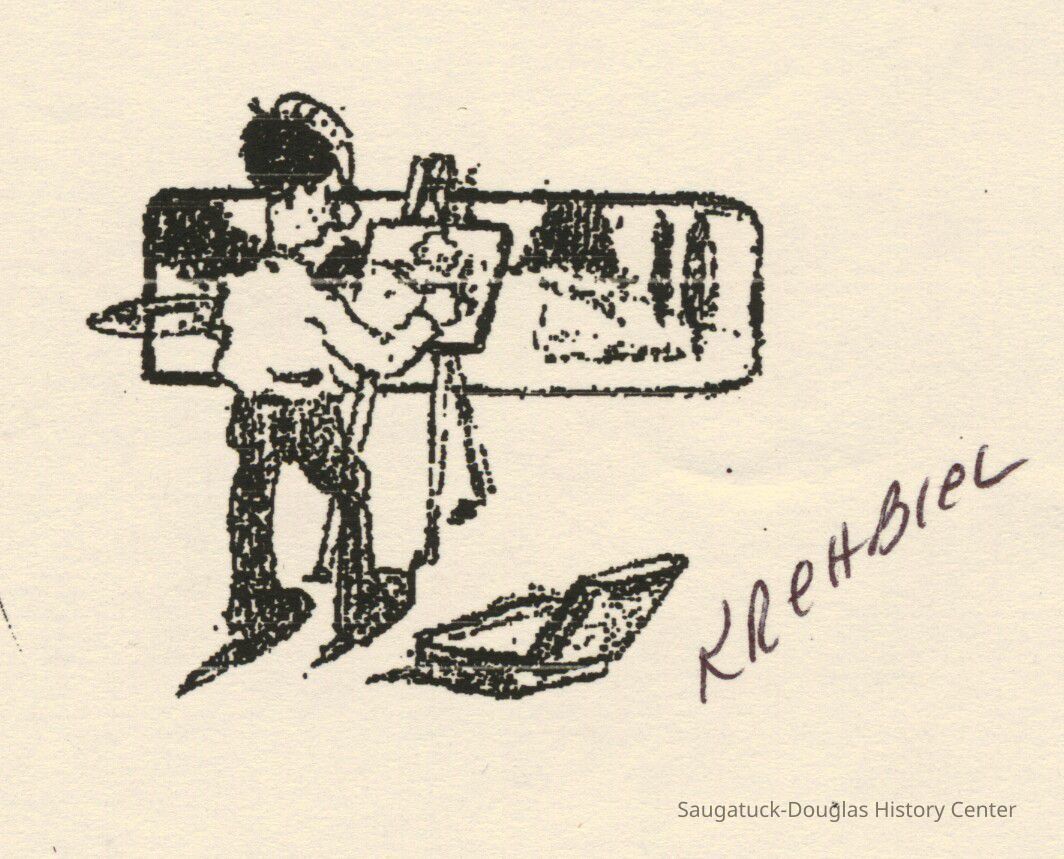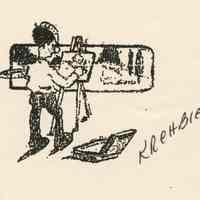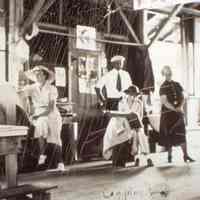Recollections of Art Study in Saugatuck
Archive
Six artists recount their memories of studying or teaching art at various art schools.
1
LeRoy Neiman at Ox-Bow Summer School of Painting
LeRoy Neiman was an instructor of figure drawing and fashion illustration at the School of the Art Institute of Chicago in the 1950s and spent the summers of 1957 and 1958 on the staff at Ox-Bow. He began work with Playboy magazine in 1954. Neiman was described by the 1996 edition of Current Biography as "the most popular living artist in the United States" and compared with the late Norman Rockwell. His specialty is sports illustration, using a technique that adds both action of emotion to the subject. He work has appeared in many other books and magazines and he was artist for three consecutive ABC telecasts of the Olympic Games. He now lives and maintains a studio in New York City. In answer to a request for his recollections of Ox-Bow, he sent the following: "My first summer spent at Saugatuck was also the first year of my marriage to Janet Byrne who had also been a student of the Art Institute of Chicago.
Another year I brought my friend Shel Silverstein, the cartoonist and country music writer with his guitar to the Ox-Bow Summer School.
It was at Saugatuck that I'd take a model into the woods and do nature studies of the nude outdoors. My first and only lithograph I did on the school's press was a result of those sketches.
Then there was Burr Tillstrom and his puppets and the camp's cook, a lovable plump older lady who would "hit" students and faculty for paintings because she collected and loved art so much. We later discovered she was selling them.
Lots of memories -- good ones -- it's wonderful to know new generations are experiencing Saugatuck as we did."
Shel (or Shelby) Silverstein was the writer and illustrator of a series of children's books including The Giving Tree, Where the Sidewalks End and The Light in the Attic. He also wrote country and western music, his best known song is probably "A Boy Named Sue" later recorded by Johnny Cash.
2
Bill Olendorf at Ox-Bow Summer School of Painting
The recollections below are excerpts from a long video interview by John Leben in December of 1995. Olendorf was a commercial artist who painted destinations for airlines and travel companies, scenes for a Dutch travel agency, and a series of stock exchanges. He also provided illustrations for four books and many other commercial art applications. At the same time, during his travels, he painted large canvases in bright colors of scenes and activity, that were, and continue to be, popular with midwest art collectors. The Olendorf family bought a cottage on the Ganges lakeshore in 1948 and, in the 1970s and 1980s, were investors in the Red Barn Theater. Bill Olendorf died in February, 1996.
"Ox-Bow was a very influential part of my art life, my career. I had studied art in both high school and in college, but never got totally into the art business as a way of life, until somebody talked me into taking a week at Ox-Bow as a student on my vacation. It was such a completely different atmosphere from anything I had ever experienced in the art world. It was a completely remote area. Everyone who was there was there to enjoy themselves and study the world of art , I had painted in Chicago at the Old Town Art Center and studied art there, taken a few courses at the Art Institute, not anything to be serious about; I wasn't serious at Ox-Bow either, but I became so enveloped in the art world there. I thought, "God what a marvelous place this is." My teachers there were outstanding, so laid back. They were genteel, really class people.
There was always a group of young kids, from the Art Institute who had come to Ox-Bow. I was always impressed with their desire to progress. I hear that some of them today are very successful internationally known painters.
First of all, we concentrated on technique. They had excellent teachers showing you the current techniques of painting. Secondly, they talked about concepts of thinking out what you wanted to do. I can remember going out in classes and watching 25 people stare at a little bush where a bunch of butterflies were landing, catching the color with the sunshine beating down on the greens, browns and blacks, just color, and appreciating it... Painting is recording beauty, that seemed to be the major thrust of the Ox-Bow people.
I kept coming back year after year. Every year at the end of the season they had a celebration and as part of the pageant they would have the model of the year, usually a very attractive young Art Institute model, standing up in a rowboat coming across the bay with one or two guys rowing her in. It was a beautiful sight seeing this naked young lady being rowed across the water.
One of my best pals was one of the top photographers of Life magazine. He just went up there to spend time photographing wild animals, bugs, flies, everything you could imagine. He always had a camera out, and at the end of the summer he had a collection of marvelous scenes that went into Life magazine.
LeRoy Neiman was a young man working at a Chicago department store illustrating men's fashion ads when I first met him. He was a very talented person. He used to teach at Ox-Bow and came with his wife, Janet, for a cocktail at my house on the lake. Five years later we were doing the same thing in Paris at the Gaslight Club.
I was in one or two Chicago Art Institute shows and the last one I went to LeRoy Neiman and I went together. He picked me up in a taxi cab and we went to the Art Institute because we knew our paintings would be in this show. As we walked into the show he said, "I have a feeling that this is the last show we're going to be in at this museum." I agreed and we walked all the way around. And, sure enough, there was his painting and there was mine. And the Best of Show was a painting, all black. A fancy frame and all black. That was the best of show. He looked at me. I looked at him. We both had a big laugh. This is what the world of art is coming to. And he said, "This is why we will never be back in another show at the Art Institute." We went out and had a drink and a big laugh, and that was the end of it.
It was the best of times, learning how to paint with the best of people with the most attractive young models and the most interested art students that you can imagine. It was marvelous to walk through that high grass, looking at some attractive young lady ahead of you getting ready to stop somewhere and do a painting, with all that sunshine and high grass. Like being alone in the world. Something special."
3
Marti Peterkin at Taylor Art School
In an oral interview with Patti Rickets in 1996 Marti Peterkin talked briefly about her study and friendship with Cora Bliss Taylor who ran an art school in Saugatuck from 1931 to 1980.
"I am a watercolorist and studied with Cora Bliss Taylor and we would come here [where the Harbors Health Care Facility was later built and paint and it was beautiful.
Cora Bliss Taylor was written up in Who's Who, she was a very famous person. Genevieve Coatoam and I would help her every year with a party for her students.
She always wore a hat, beautiful hats. She started the interurban and I was so proud of her. She was a lot of fun. I enjoyed her."
4
The Coffey Family at Taylor Art School
"My daughters, Angle and Jenny, took art lessons from Mrs. Taylor for a few summers. They have many happy memories of these special times.
Mrs. Taylor in her big, flower-trimmed hat, was always smiling and encouraging the students in her art class. Patience was needed and she had it in
abundance. She never seemed to lose her "cool." The class was unstructured, the students working at their own level and pace.
Children met for lessons on summer mornings in the backyard of the Taylor home on Mason Street. On sunny days the students sat outside and painted whatever held their interest. On rainy days they worked in her studio.
Sometimes she would take them on a walk around town to paint the sights of Saugatuck. She always had treats at the end of class and the children looked forward to that. An art exhibition of work by the children was held at the end of summer. A clothesline exhibit displayed the paintings and the children could invite their family and friends. Mrs. Taylor talked to all the adults about the children's work and progress, but more importantly, she listened to the children and praised their work.
She seemed to genuinely enjoy the kids. She told them stories about places she had visited and what life was life when she was young. She instilled in them an interest and desire to travel. They thought she was very 'worldly'." -- Ginger Coffey
5
SyIvia Miller Randolph at AK Studio
"Albert H. Krehbiel was a slim and spry man. He had a sharp chin with a goatee and iron gray hair over which he usually wore a hat.
There were three in my family who took lessons, me, my sister and my mother who was about 60 at the time. He would say, "Here comes the Miller family." My mother and sister stayed at the Maplewood where Krehbiel had some of his meals, and may have stayed, and my husband and I sometimes went there for meals on their big porch.
We would go down to his studio by the waterfront at 9 a.m. and usually paint indoors in the morning, when it was still cold or if it was raining. We did a lot of interiors at the fisherman's shack and the carpentry shop near the studio.
Then we would go home for lunch and paint scenes around town in the afternoon. This was back when there weren't many cars and we had to walk and carry all of our painting equipment up the hill to the Congregational Church, or anywhere else we had selected to paint. He was always impressed with how straight my mother stood, even when she was loaded down with her paint boxes.
He would say, "There's no bend in her back at all," even though she was past 60.
She usually signed her paintings "E. Z. Miller" using her initials, and he kidded her about that because mother was a tee-totaller and very traditional, anything but "easy."
He helped his students as they were painting and would occasionally use a brush on a student's painting to make a point, or sometimes draw a suggestion on the border. I didn't like him to touch my painting so I would say, "Just tell me, Albert."
Mr. Krehbiel always made a point of putting warm colors in the ground. He was great for color and the ground did usually look warm, especially against the green of the leaves and the trees. We enjoyed him, he was spry and full of life."
6
Winifred C. Flack at AK Studio
"The lessons were held in a frame building, dark red in color, that was torn down to make room for the Ship 'n Shore motel-boatel. It had a dutch door, unusual for this area. You could talk through the upper half and leave the bottom closed.
We didn't paint much as a class in the studio. We would have sketching sessions and figure drawing, and talk about ideas and theories. In the afternoons we would go out on location and do our own individual paintings.
Mr. Krehbiel would say very little while we were painting, and there was little interference with what a student was doing, but we would sometimes have critique sessions where Mr. Krehbiel and the other students would discuss your paintings.
He used to tell us that an artist needed to look at what they wanted to paint and make a real plan in their head before beginning to paint. He said, "You should study what you want to do for an hour, then do it in 10 minutes." Study it first, so that you really knew the scene and then you could paint the essence of it.
The time was all work, not a tedious kind of work, but very intense and interesting as we learned to transfer what we could see to the canvas. It was a very stimulating time."

2023.50.16
SDHS NL Inserts
Winthers, Sally
2023.50
Found in Collection
SDHS Newsletter insert pages 25-27
Digital data in CatalogIt
Neiman, LeRoy 1921-2012Olendorf, William "Bill" Carr 1925-1966Ox-Bow/Summer School of ArtTaylor Art School 1931-Taylor, Cora Bliss 1889-1986Peterkin, MartiBekken, Sylvia Anna Edna (Miller) Randolph 1905-2008Krehbiel, Albert Henry 1873-1945Ox-Bow Village Studio/AK Studio
This information was OCR text scanned from SDHS newsletter supplements. A binder of original paper copies is catalog item 2023.50.01
11/08/2023
01/09/2024


